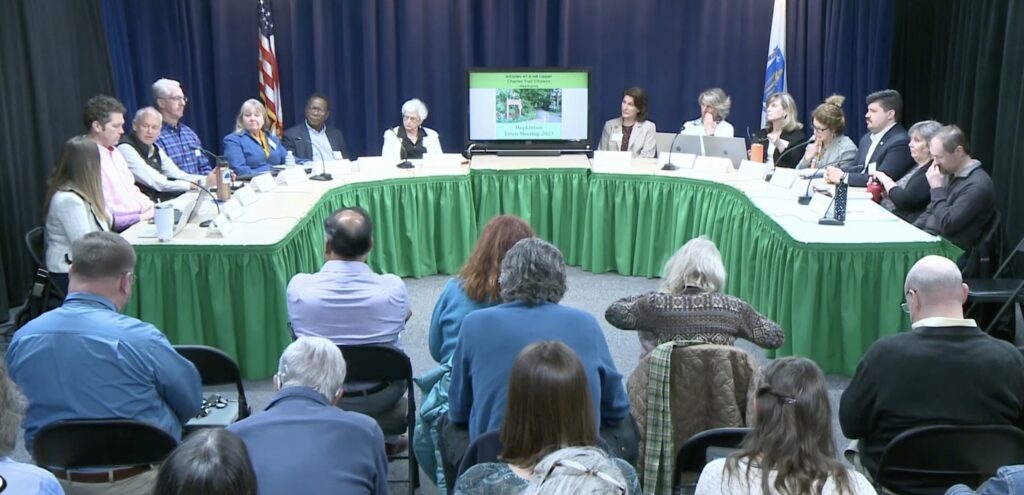Residents got a Town Meeting primer Monday night via the ninth annual Know Your Vote forum sponsored by eHop and broadcast on HCAM.
The nearly two-hour event featured a number of town officials and board members who explained the most crucial articles for Annual Town Meeting and Special Town Meeting, both of which will take place Saturday beginning at 9 a.m. under a tent at the high school’s football field.
Nanda Barker-Hook, eHop’s president, explained that the town will be voting on a budget of $98,724,738, which will have a 2.86 percent tax impact. This would amount to a $320 tax increase for an average home worth $655,500.
The school budget comes in at just under $54 million, a 5.4 percent increase over Fiscal Year 2021. The district is projecting 74 projected new students for the 2021-22 school year.
Two key articles pertain to the schools: Article 17 and Article 19. Article 17 calls for $3,625,000 to add four classrooms to Marathon School. Article 19 requests $3 million to replace large areas of the roofs at Hopkins School and Hopkinton Middle School. Both items are debt exclusions and also will require passage at Town Election on May 22 in order to move forward.
Town Meeting moderator Tom Garabedian said Saturday’s meeting will be held rain or shine. Residents must sign in and will be required to wear masks and socially distance.
“At this point we anticipate opening the Annual Town Meeting first, immediately adjourning it, and then opening the Special Town Meeting so that we can conduct the two Special Town Meeting articles first,” he said. “We’ll conclude that business and then we’ll move back to the Annual Town Meeting and march through the 44 articles.”
He added that he expected to complete the agenda by Saturday afternoon.
A Special Town Meeting needs to be convened because the warrant had been closed when two new time-sensitive articles arose.
Select Board vice chair Irfan Nasrullah fielded questions regarding the budget. He noted that in addition to providing level services, the budget would call for “specific targeted increases.” This would include 18.5 new positions within the Hopkinton Public Schools at a cost of $959,265. There also would be a new patrol officer added to the Hopkinton Police Department. Youth and Family Services would receive the equivalent of less than one full-time employee, and Senior Services would add a driver.
The need for more classroom space and the aging of current school buildings were key drivers in the budget that generated the most questions.
One individual asked about the need for an $80,000 planning study for the Hopkinton Public Schools. Superintendent Carol Cavanaugh noted that in December 2019, all of the facilities were surveyed about projected enrollment versus square footage. The assessment found that with projected enrollments over a decade, the schools would be 187,000 square feet short of space to accommodate students.
“That’s a huge problem for us,” she said. “A number that has been floating around in the community is $157 million, and I know that number frightens the community.”
The feasibility study for Elmwood School and the district-wide study, she explained, are two distinct projects. The Massachusetts School Building Authority (MSBA) recently invited Hopkinton into an eligibility process for consideration for funding for either an addition or replacement of the building. The district has 270 days to come up with $1 million if it is chosen to have a feasibility study. However, that 270 days would fall before the next Annual Town Meeting, which is why that request was added as part of Special Town Meeting. That money would come out of the Legacy Farms host community agreement.
“It’s the second-oldest building in our community and it’s certainly in the poorest condition,” Cavanaugh said of Elmwood.
By contrast, the district-wide study will analyze each building, the feasibility of adding onto the buildings, the impact on traffic patterns and other factors.
“We really want to make sure we get this right,” Cavanaugh said. “And along the way, we’ll be bringing the community along with us. What we want to make sure is that the community has a chance to weigh in on these projects.”
School Committee chair Amanda Fargiano said this planning will help Hopkinton stay “ahead of the crunch” in school enrollment.
“We want to look across the entire set of buildings and figure out where we go and how we address the growth,” she said, noting that some of the space needed would include cafeterias.
The Marathon School expansion debt exclusion also was an issue. An additional preschool classroom had to be added due to special education requirements, as well as an intensive education classroom. This took away space that had been allocated for a health room and art room.
“We’re really concerned about what’s happened to this sort of state-of-the-art facility with all of these wonderful attributes,” she said. “And now we’re kind of dismantling this building, if you will, piece by piece because of enrollment growth.”
The building also lacks small-group spaces that would accommodate English language learners, she added.
The average household would contribute $47 in taxes toward the project, she noted, for additional classrooms if the articles on the Marathon School were to pass.
The roof replacement for Hopkins and the middle school was another issue raised. Both roofs have been deemed by engineers to be at “end of life,” according to Cavanaugh. The tax impact would be $40. Solar panels are being researched for the new roofs.
Two solar zoning articles also were discussed. Planning Board chair Gary Trendel noted that they are independent articles that are “intended to do two different things.”
Article 35 is an overhaul of the current commercial ground-mounted solar array bylaws. It is intended to “eliminate the visual impact of these solar installations,” he explained. It would also require a site plan review for commercial solar installations, provide visual shielding for the life of the project and provide environmental enhancements such as wildlife-friendly fencing and relocating trails impacted by the panels. Seed mixtures must be pollinator-friendly, and measures would be put into place for noise and glare mitigation.
“It really gives the Planning Board a lot more leeway to minimize what we think is one of the primary negative impacts of commercial solar installations,” Trendel said.
The second article would create a solar overlay district, primarily in parcels along the Interstate 495 corridor. Trendel noted that this may be challenged in court because the state currently allows commercial solar everywhere. There is no current case law to predict what the outcome would be.
Neither article has any impact on using solar panels as an accessory use, such as on a home’s roof, he added.
The EMC skate park article for $350,000 also came up. Parks & Recreation Committee chair Dan Terry said that more than a dozen people spoke in favor of the project at a Community Preservation Committee meeting in 2019. The design is nearly completed and should be presented next week, he said. The park is concrete and would be nearly maintenance-free. Netting would need to be installed, but that is a separate item that was planned regardless of the skate park, in order to protect children who play next to the abutting baseball field.















0 Comments